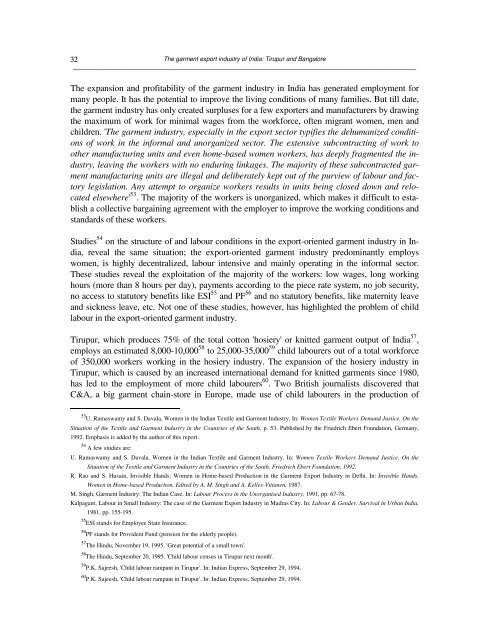You also want an ePaper? Increase the reach of your titles
YUMPU automatically turns print PDFs into web optimized ePapers that Google loves.
32<br />
The <strong>garment</strong> <strong>export</strong> <strong>in</strong>dustry <strong>of</strong> <strong>India</strong>: Tirupur <strong>and</strong> Bangalore<br />
──────────────────────────────────────────────────────────────────────────────────────────────<br />
The expansion <strong>and</strong> pr<strong>of</strong>itability <strong>of</strong> <strong>the</strong> <strong>garment</strong> <strong>in</strong>dustry <strong>in</strong> <strong>India</strong> has generated employment for<br />
many people. It has <strong>the</strong> potential to improve <strong>the</strong> liv<strong>in</strong>g conditions <strong>of</strong> many families. But till date,<br />
<strong>the</strong> <strong>garment</strong> <strong>in</strong>dustry has only created surpluses for a few <strong>export</strong>ers <strong>and</strong> manufacturers by draw<strong>in</strong>g<br />
<strong>the</strong> maximum <strong>of</strong> work for m<strong>in</strong>imal wages from <strong>the</strong> workforce, <strong>of</strong>ten migrant women, men <strong>and</strong><br />
children. 'The <strong>garment</strong> <strong>in</strong>dustry, especially <strong>in</strong> <strong>the</strong> <strong>export</strong> sector typifies <strong>the</strong> dehumanized conditions<br />
<strong>of</strong> work <strong>in</strong> <strong>the</strong> <strong>in</strong>formal <strong>and</strong> unorganized sector. The extensive subcontract<strong>in</strong>g <strong>of</strong> work to<br />
o<strong>the</strong>r manufactur<strong>in</strong>g units <strong>and</strong> even home-based women workers, has deeply fragmented <strong>the</strong> <strong>in</strong>dustry,<br />
leav<strong>in</strong>g <strong>the</strong> workers with no endur<strong>in</strong>g l<strong>in</strong>kages. The majority <strong>of</strong> <strong>the</strong>se subcontracted <strong>garment</strong><br />
manufactur<strong>in</strong>g units are illegal <strong>and</strong> deliberately kept out <strong>of</strong> <strong>the</strong> purview <strong>of</strong> <strong>labour</strong> <strong>and</strong> factory<br />
legislation. Any attempt to organize workers results <strong>in</strong> units be<strong>in</strong>g closed down <strong>and</strong> relocated<br />
elsewhere' 53 . The majority <strong>of</strong> <strong>the</strong> workers is unorganized, which makes it difficult to establish<br />
a collective barga<strong>in</strong><strong>in</strong>g agreement with <strong>the</strong> employer to improve <strong>the</strong> work<strong>in</strong>g conditions <strong>and</strong><br />
st<strong>and</strong>ards <strong>of</strong> <strong>the</strong>se workers.<br />
Studies 54 on <strong>the</strong> structure <strong>of</strong> <strong>and</strong> <strong>labour</strong> conditions <strong>in</strong> <strong>the</strong> <strong>export</strong>-<strong>oriented</strong> <strong>garment</strong> <strong>in</strong>dustry <strong>in</strong> <strong>India</strong>,<br />
reveal <strong>the</strong> same situation; <strong>the</strong> <strong>export</strong>-<strong>oriented</strong> <strong>garment</strong> <strong>in</strong>dustry predom<strong>in</strong>antly employs<br />
women, is highly decentralized, <strong>labour</strong> <strong>in</strong>tensive <strong>and</strong> ma<strong>in</strong>ly operat<strong>in</strong>g <strong>in</strong> <strong>the</strong> <strong>in</strong>formal sector.<br />
These studies reveal <strong>the</strong> exploitation <strong>of</strong> <strong>the</strong> majority <strong>of</strong> <strong>the</strong> workers: low wages, long work<strong>in</strong>g<br />
hours (more than 8 hours per day), payments accord<strong>in</strong>g to <strong>the</strong> piece rate system, no job security,<br />
no access to statutory benefits like ESI 55 <strong>and</strong> PF 56 <strong>and</strong> no statutory benefits, like maternity leave<br />
<strong>and</strong> sickness leave, etc. Not one <strong>of</strong> <strong>the</strong>se studies, however, has highlighted <strong>the</strong> problem <strong>of</strong> child<br />
<strong>labour</strong> <strong>in</strong> <strong>the</strong> <strong>export</strong>-<strong>oriented</strong> <strong>garment</strong> <strong>in</strong>dustry.<br />
Tirupur, which produces 75% <strong>of</strong> <strong>the</strong> total cotton 'hosiery' or knitted <strong>garment</strong> output <strong>of</strong> <strong>India</strong> 57 ,<br />
employs an estimated 8,000-10,000 58 to 25,000-35,000 59 child <strong>labour</strong>ers out <strong>of</strong> a total workforce<br />
<strong>of</strong> 350,000 workers work<strong>in</strong>g <strong>in</strong> <strong>the</strong> hosiery <strong>in</strong>dustry. The expansion <strong>of</strong> <strong>the</strong> hosiery <strong>in</strong>dustry <strong>in</strong><br />
Tirupur, which is caused by an <strong>in</strong>creased <strong>in</strong>ternational dem<strong>and</strong> for knitted <strong>garment</strong>s s<strong>in</strong>ce 1980,<br />
has led to <strong>the</strong> employment <strong>of</strong> more child <strong>labour</strong>ers 60 . Two British journalists discovered that<br />
C&A, a big <strong>garment</strong> cha<strong>in</strong>-store <strong>in</strong> Europe, made use <strong>of</strong> child <strong>labour</strong>ers <strong>in</strong> <strong>the</strong> production <strong>of</strong><br />
53 U. Ramaswamy <strong>and</strong> S. Davala, Women <strong>in</strong> <strong>the</strong> <strong>India</strong>n Textile <strong>and</strong> Garment Industry. In: Women Textile Workers Dem<strong>and</strong> Justice. On <strong>the</strong><br />
Situation <strong>of</strong> <strong>the</strong> Textile <strong>and</strong> Garment Industry <strong>in</strong> <strong>the</strong> Countries <strong>of</strong> <strong>the</strong> South, p. 53. Published by <strong>the</strong> Friedrich Ebert Foundation, Germany,<br />
1992. Emphasis is added by <strong>the</strong> author <strong>of</strong> this report.<br />
54 A few studies are:<br />
U. Ramaswamy <strong>and</strong> S. Davala, Women <strong>in</strong> <strong>the</strong> <strong>India</strong>n Textile <strong>and</strong> Garment Industry. In: Women Textile Workers Dem<strong>and</strong> Justice. On <strong>the</strong><br />
Situation <strong>of</strong> <strong>the</strong> Textile <strong>and</strong> Garment Industry <strong>in</strong> <strong>the</strong> Countries <strong>of</strong> <strong>the</strong> South. Friedrich Ebert Foundation, 1992.<br />
R. Rao <strong>and</strong> S. Husa<strong>in</strong>, Invisible H<strong>and</strong>s: Women <strong>in</strong> Home-based Production <strong>in</strong> <strong>the</strong> Garment Export Industry <strong>in</strong> Delhi. In: Invisible H<strong>and</strong>s.<br />
Women <strong>in</strong> Home-based Production. Edited by A. M. S<strong>in</strong>gh <strong>and</strong> A. Kelles-Viitanen, 1987.<br />
M. S<strong>in</strong>gh, Garment Industry: The <strong>India</strong>n Case. In: Labour Process <strong>in</strong> <strong>the</strong> Unorganised Industry, 1991, pp. 67-78.<br />
Kalpagam, Labour <strong>in</strong> Small Industry: The case <strong>of</strong> <strong>the</strong> Garment Export Industry <strong>in</strong> Madras City. In: Labour & Gender. Survival <strong>in</strong> Urban <strong>India</strong>,<br />
1981, pp. 155-195.<br />
55 ESI st<strong>and</strong>s for Employee State Insurance.<br />
56 PF st<strong>and</strong>s for Provident Fund (pension for <strong>the</strong> elderly people).<br />
57 The H<strong>in</strong>du, November 19, 1995. 'Great potential <strong>of</strong> a small town'.<br />
58 The H<strong>in</strong>du, September 20, 1995. '<strong>Child</strong> <strong>labour</strong> census <strong>in</strong> Tirupur next month'.<br />
59 P.K. Sajeesh, '<strong>Child</strong> <strong>labour</strong> rampant <strong>in</strong> Tirupur'. In: <strong>India</strong>n Express, September 29, 1994.<br />
60 P.K. Sajeesh, '<strong>Child</strong> <strong>labour</strong> rampant <strong>in</strong> Tirupur'. In: <strong>India</strong>n Express, September 29, 1994.


















